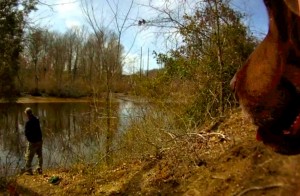tuckahoe
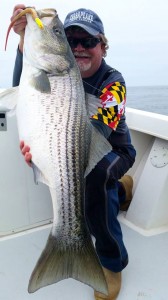 If fishing can be a feast or famine activity, anglers in the Chesapeake Bay region have been eating high on the hog lately. As is typical with April, all good things happen at once. In the past two weeks, I’ve caught shad, white perch, yellow perch, bass, bluegill, crappie, catfish, and stripers. Throw in the walleye and snakeheads my friends are catching, and we’re smack in the middle of a virtual smorgasbord of good fishing. The weather has been spotty, but that hasn’t kept too many anglers off the water. Here’s my report:
If fishing can be a feast or famine activity, anglers in the Chesapeake Bay region have been eating high on the hog lately. As is typical with April, all good things happen at once. In the past two weeks, I’ve caught shad, white perch, yellow perch, bass, bluegill, crappie, catfish, and stripers. Throw in the walleye and snakeheads my friends are catching, and we’re smack in the middle of a virtual smorgasbord of good fishing. The weather has been spotty, but that hasn’t kept too many anglers off the water. Here’s my report:
Yellow Perch: It’s all but over now, but we enjoyed one of the best March ring-perch runs in recent memory. Neds ran big this year and they were plentiful. They were also a little earlier than usual. That made it nice for those of us who were just about going crazy with cabin fever. Most of my fishing was in the Eastern Shore creeks and rivers. I fished Tuckahoe Creek and the Choptank River from Denton up to Red Bridges park. Some days it was one fish after another and on other days it was slow. Yellow perch can be finicky at times. When they are spawning they typically move up the streams in waves. If you aren’t catching, stick around because chances are another wave will move through and you’ll start getting bites again. See my earlier post for more information about the yellow perch run.
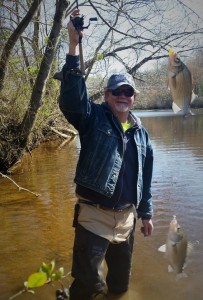 White Perch: I thought the white perch spawn might be over until I got a call from my friend Phil Kerchner last week. He was still lighting up the black backs in the creeks near his place at Wye Mills. I called him last Sunday and we met on the banks of Tuckahoe Creek. It was one pre-spawn white perch after another for a little while. Our best lures were Bust ‘Em Baits stingers and small twister tails rigged in tandem on one-sixteenth-ounce jig heads. As the tide changed, the bite slowed down, but it picked back up before sunset and we took home a very nice stringer. White perch are my favorite fish to eat. I even prefer them over crappie and I think they’re way better than yellow perch. All things in moderation of course, but don’t feel bad about keeping what you want to eat because white perch aren’t threatened and they reproduce prolifically. They will generally hang around the spawning grounds for a little while after they spawn, so I wouldn’t be surprised if we keep catching them in the creeks for a couple of more weeks. After that, they’ll spread out along the shorelines where they can be targeted all summer long.
White Perch: I thought the white perch spawn might be over until I got a call from my friend Phil Kerchner last week. He was still lighting up the black backs in the creeks near his place at Wye Mills. I called him last Sunday and we met on the banks of Tuckahoe Creek. It was one pre-spawn white perch after another for a little while. Our best lures were Bust ‘Em Baits stingers and small twister tails rigged in tandem on one-sixteenth-ounce jig heads. As the tide changed, the bite slowed down, but it picked back up before sunset and we took home a very nice stringer. White perch are my favorite fish to eat. I even prefer them over crappie and I think they’re way better than yellow perch. All things in moderation of course, but don’t feel bad about keeping what you want to eat because white perch aren’t threatened and they reproduce prolifically. They will generally hang around the spawning grounds for a little while after they spawn, so I wouldn’t be surprised if we keep catching them in the creeks for a couple of more weeks. After that, they’ll spread out along the shorelines where they can be targeted all summer long.
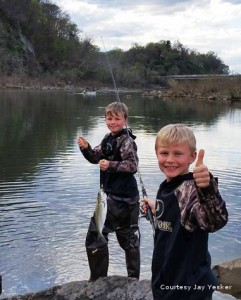 Shad: The shad run is in full swing. I’ve fished the Potomac around Fletcher’s Cove and Chain Bridge twice now and found shad in good numbers both times. Joe Yack is reporting shad in the Susquehanna now as well. The good news is that hickory shad are running big this year. I’ve seen at least two reports of hicks approaching five pounds. Some anglers mistakenly identify bigger hickory shad as white (American) shad because, when they are fully mature, they lose the spots on their shoulders. The key to identifying shad is to look at the lower jaw. If the lower jaw projects beyond the upper one with the mouth closed, it’s a hickory. I typically cast one-quarter or one-eighth ounce shad darts. It pays to experiment when you’re shad fishing because the same colors and techniques that work one day might not work the next. Last week, my fishing buddy Jay Yesker out-fished me by snap-jigging two quarter-ounce darts on eight-pound-test monofilament. (That’s Jay’s boys in the picture.) The fish were taking on the fall. Since my usual spinning rig is eight-pound-test braid with a similar size fluorocarbon leader, I couldn’t duplicate what he was doing because the force of the snap using the stretchless braid would break my leader. You can bet I was rigged with mono the next time I went out, but wouldn’t you know it, on that day the fish wanted a steady fast retrieve! You just don’t know until you go. The shad run should last for several more weeks, so there’s still plenty of time to get in on the action. Read More!
Shad: The shad run is in full swing. I’ve fished the Potomac around Fletcher’s Cove and Chain Bridge twice now and found shad in good numbers both times. Joe Yack is reporting shad in the Susquehanna now as well. The good news is that hickory shad are running big this year. I’ve seen at least two reports of hicks approaching five pounds. Some anglers mistakenly identify bigger hickory shad as white (American) shad because, when they are fully mature, they lose the spots on their shoulders. The key to identifying shad is to look at the lower jaw. If the lower jaw projects beyond the upper one with the mouth closed, it’s a hickory. I typically cast one-quarter or one-eighth ounce shad darts. It pays to experiment when you’re shad fishing because the same colors and techniques that work one day might not work the next. Last week, my fishing buddy Jay Yesker out-fished me by snap-jigging two quarter-ounce darts on eight-pound-test monofilament. (That’s Jay’s boys in the picture.) The fish were taking on the fall. Since my usual spinning rig is eight-pound-test braid with a similar size fluorocarbon leader, I couldn’t duplicate what he was doing because the force of the snap using the stretchless braid would break my leader. You can bet I was rigged with mono the next time I went out, but wouldn’t you know it, on that day the fish wanted a steady fast retrieve! You just don’t know until you go. The shad run should last for several more weeks, so there’s still plenty of time to get in on the action. Read More!
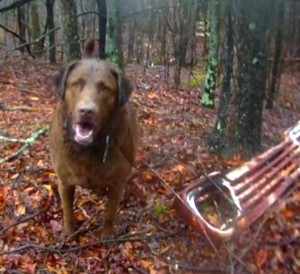 This is the time of year I like to walk along Tuckahoe Creek near Queen Anne, Maryland casting for perch and chain pickerel. For the past couple of years I’ve only caught white perch on the Tuckahoe. I’ve missed the earlier yellow perch spawn because it frequently coincides with the first wave of pre-spawn rockfish. I thought I might miss it again this year, but today’s rainy windy weather kept me off the Bay. My four-year-old Chesapeake Bay Retriever Crockett and I left Kent Island about noon and took the long way around before parking the truck and hiking in to my favorite perch holes. The rain poured and the fish bit. It wasn’t hot and heavy like I’ve been hearing about in the Western Shore creeks, but I finished up with six keepers out of a couple dozen perch, and released a nice pickerel. My lure was a chartreuse one-thirty-second ounce feather fly tied by my Severn River Rod & Keg Club brother Woody of Maryland Tackle. I jigged it under a tiny green top float. A feather fly coupled with a buoyant, lively float is a combination my dad taught me. My brother Creig has been wearing out the crappie in the TVA lakes using it. It’s a very specific technique because any old float won’t work. I think I’ll keep the brand name to myself for now, but you might be able to figure it out from the video. It was great to get out and stream fish for a while. I’ll visit the Tuckahoe again once the white perch run begins. As you can tell, Crockett is in his element in the rainy woods. Read More!
This is the time of year I like to walk along Tuckahoe Creek near Queen Anne, Maryland casting for perch and chain pickerel. For the past couple of years I’ve only caught white perch on the Tuckahoe. I’ve missed the earlier yellow perch spawn because it frequently coincides with the first wave of pre-spawn rockfish. I thought I might miss it again this year, but today’s rainy windy weather kept me off the Bay. My four-year-old Chesapeake Bay Retriever Crockett and I left Kent Island about noon and took the long way around before parking the truck and hiking in to my favorite perch holes. The rain poured and the fish bit. It wasn’t hot and heavy like I’ve been hearing about in the Western Shore creeks, but I finished up with six keepers out of a couple dozen perch, and released a nice pickerel. My lure was a chartreuse one-thirty-second ounce feather fly tied by my Severn River Rod & Keg Club brother Woody of Maryland Tackle. I jigged it under a tiny green top float. A feather fly coupled with a buoyant, lively float is a combination my dad taught me. My brother Creig has been wearing out the crappie in the TVA lakes using it. It’s a very specific technique because any old float won’t work. I think I’ll keep the brand name to myself for now, but you might be able to figure it out from the video. It was great to get out and stream fish for a while. I’ll visit the Tuckahoe again once the white perch run begins. As you can tell, Crockett is in his element in the rainy woods. Read More!



